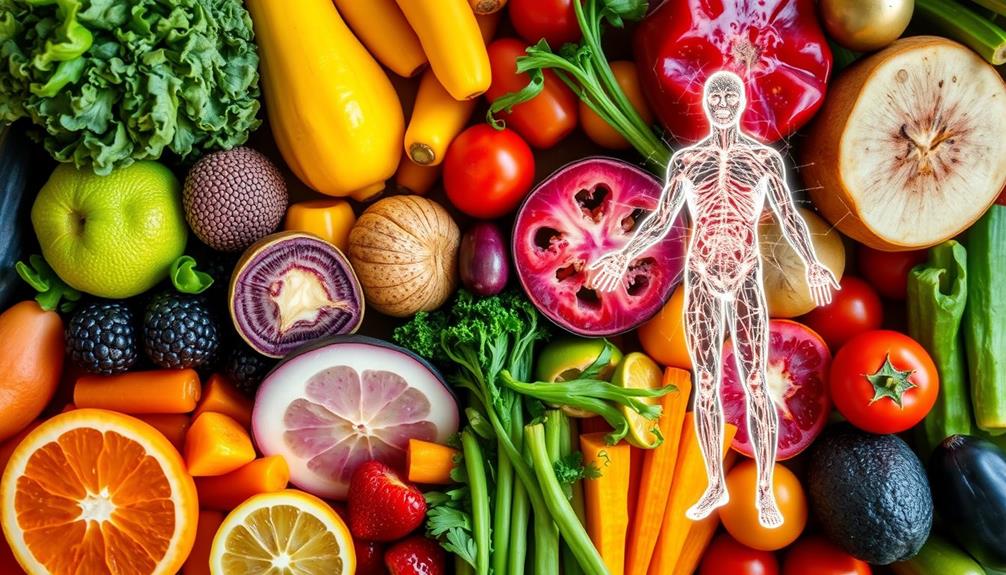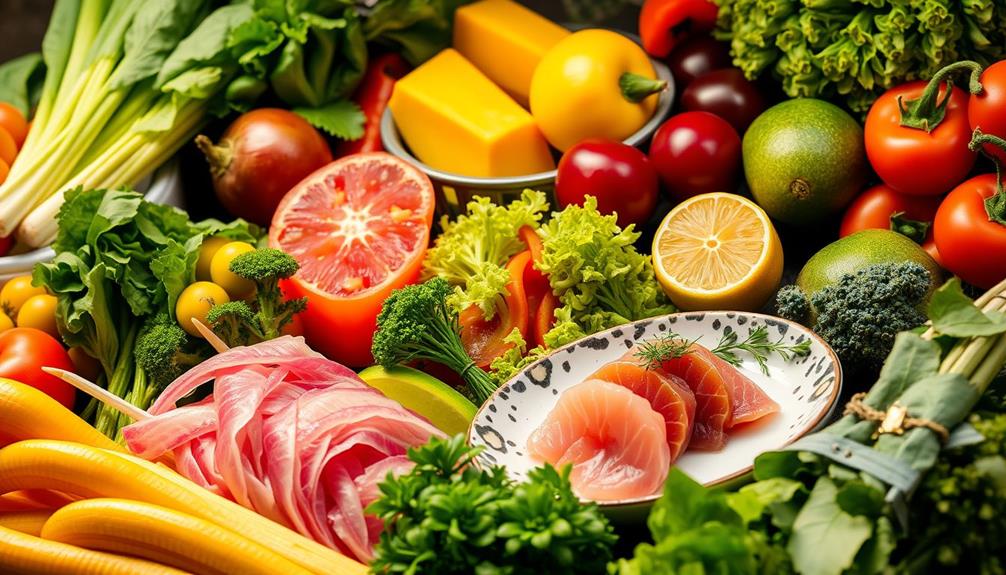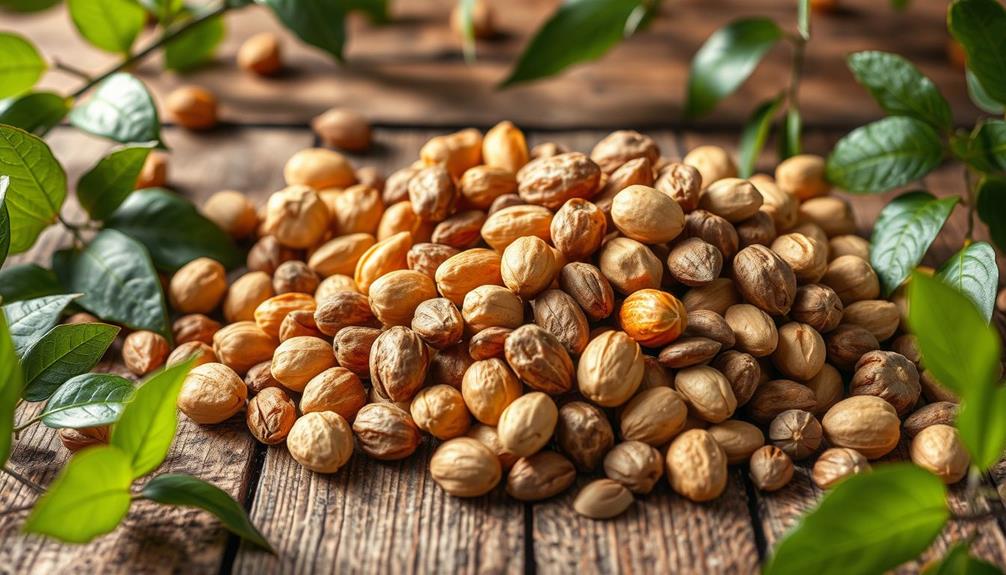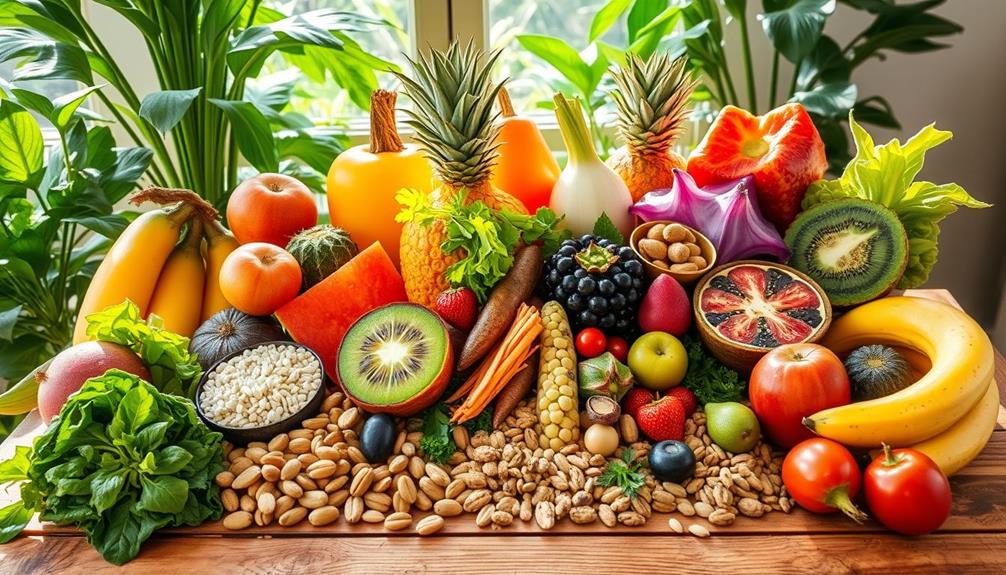Raw food can transform your body by boosting your energy and improving digestion. You'll enjoy a nutrient-rich diet filled with vitamins, minerals, and antioxidants from fruits and vegetables. High fiber content aids gut health and can help with weight loss, as you'll be consuming fewer calories while feeling full. However, be cautious of potential nutrient deficiencies, particularly in vitamin B12 and iron, if you don't plan your meals carefully. While the benefits are enticing, there are also challenges to reflect upon. If you want to find out more about traversing this diet, keep going to uncover essential tips.
Key Takeaways
- A raw food diet enhances nutrient intake, providing essential vitamins, minerals, and antioxidants that support overall health and disease prevention.
- High fiber content promotes digestive health, aiding in regular bowel movements and supporting beneficial gut bacteria.
- Long-term adherence may lead to nutrient deficiencies, particularly in vitamin B12, calcium, and iron, requiring careful meal planning.
- Raw foods can enhance digestive efficiency through natural enzymes, although some individuals may experience bloating and digestive discomfort initially.
- A raw food diet may facilitate weight loss due to low-calorie density and increased satiety from high-fiber foods.
Overview of Raw Food Diet
The raw food diet emphasizes eating uncooked and unprocessed foods, primarily focusing on fruits, vegetables, nuts, seeds, and sprouted grains. This approach often involves preparation methods like blending, juicing, soaking, and dehydrating at temperatures below 118°F (48°C) to preserve nutrients. Advocates believe that consuming these nutrient-dense plant foods enhances health benefits, including improved energy levels and weight loss, thanks to their high fiber and low-calorie content.
Additionally, incorporating foods like celery juice can offer anti-inflammatory properties that align with the raw food philosophy.
However, while many experience positive effects, it's important to recognize potential risks. The restrictive nature of the raw food diet can lead to nutrient deficiencies, especially in vitamin B12, protein, iron, and omega-3 fatty acids. To mitigate these risks, careful meal planning is significant. You'll need to verify you're getting a balanced intake of key nutrients, which might also involve supplementation.
Additionally, the raw food diet can present social challenges and complicate adherence, as dining out or attending events may become difficult. Monitoring your overall nutrient intake is essential for maintaining health while following this diet.
If you're considering this lifestyle, be prepared to navigate these challenges to reap the benefits effectively.
Nutritional Benefits
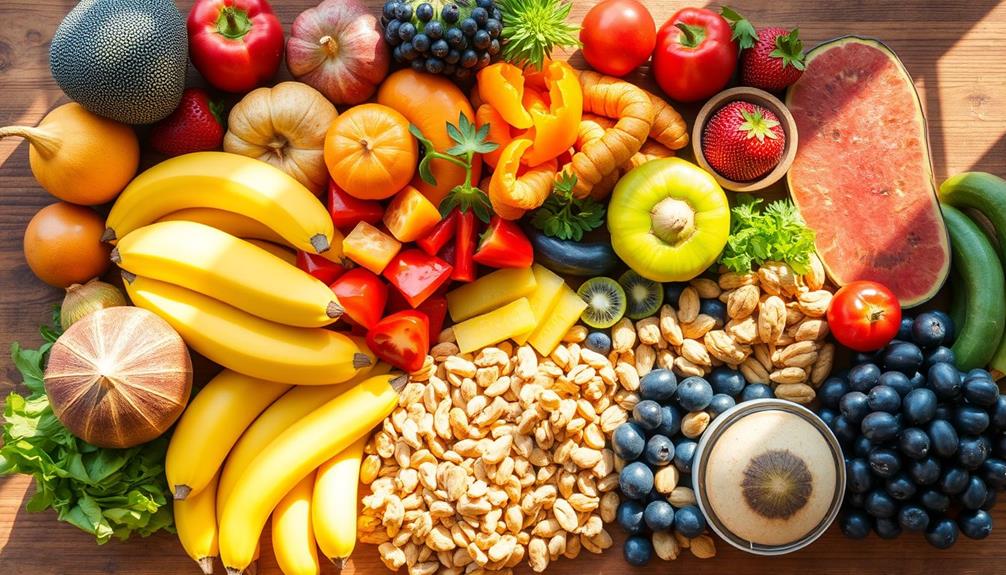
Many people find that a raw food diet offers notable nutritional benefits that can enhance overall health. This diet is rich in nutrient-dense fruits and vegetables, providing essential vitamins, minerals, and antioxidants that boost your energy levels and overall well-being.
The high fiber content in raw food promotes digestive health, supporting gut bacteria and possibly reducing inflammation and gastrointestinal disorders. Additionally, incorporating natural remedies alongside conventional medications can complement the benefits of a raw food diet.
Switching to raw foods can also lead to effective weight loss, with studies showing participants losing an average of 22-26 pounds over 3.5 years. Additionally, consuming raw foods is linked to lower blood pressure and cholesterol levels, which can greatly reduce your risk of heart disease.
Moreover, the increased intake of raw produce is associated with a decreased risk of chronic diseases, including type 2 diabetes. This is largely due to the low-calorie density and high fiber content of these foods, making them not only nutritious but also filling.
Potential Health Risks
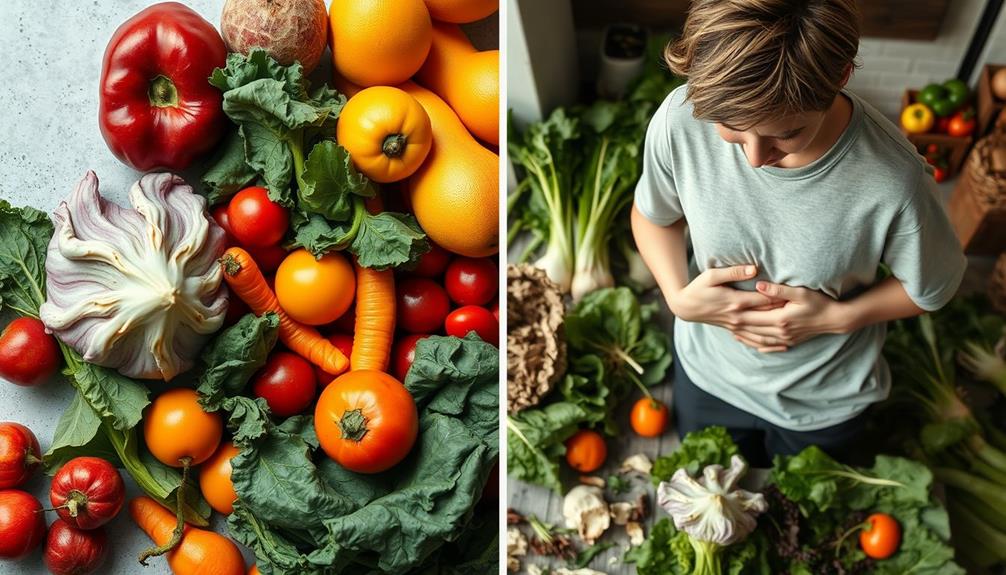
Adopting a raw food diet can come with significant health risks that you should consider. One major concern is nutrient deficiencies. Long-term adherence to this diet can leave you lacking essential nutrients like vitamin B12, calcium, and iron, potentially causing anemia and bone health issues.
Women on a raw vegan diet face particular challenges; studies show that 70% report menstrual irregularities, with those consuming only raw foods being seven times more likely to experience amenorrhea. Additionally, certain essential oils, like eucalyptus oil and peppermint oil, can support respiratory health, which may be beneficial if you're experiencing issues related to nutrient deficiencies.
Additionally, consuming raw animal products, such as dairy and eggs, increases your risk of foodborne illness from pathogens like E. coli and Salmonella. This can raise serious health concerns.
The low-calorie density of a raw food diet may also lead to significant weight loss, which, if not managed properly, can result in muscle loss and negatively impact your metabolic health.
Food Safety Concerns
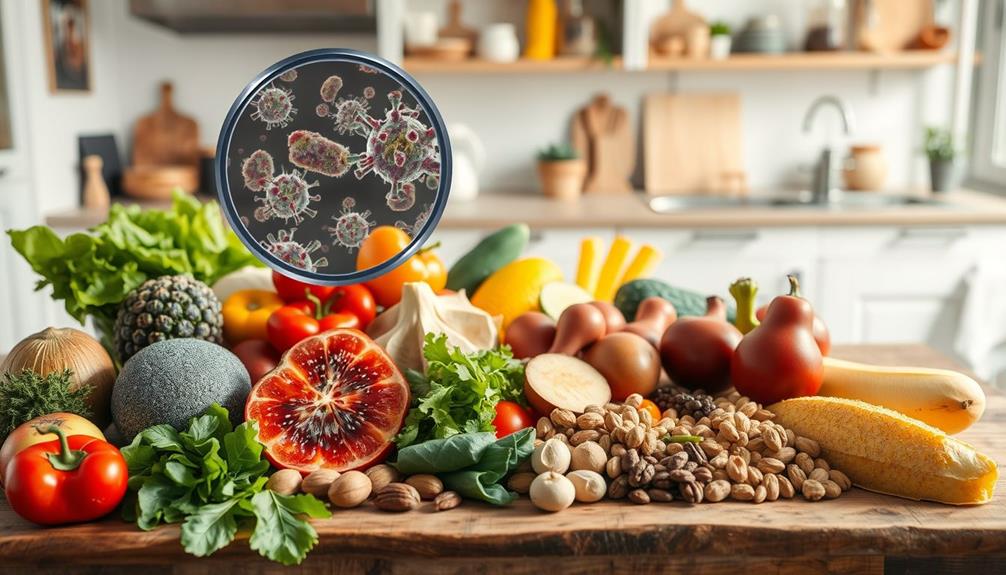
When you choose to eat raw foods, you need to be aware of the potential risks from pathogens like E. coli and Salmonella.
Mammography aims to detect breast cancer early for better treatment outcomes, similar to how safe handling practices, including proper washing and cooking, are essential to prevent foodborne illnesses.
Understanding these risks can help you make informed decisions about your diet.
Pathogen Risks in Raw Foods
Raw foods can be a double-edged sword when it comes to health, especially with the potential presence of harmful pathogens. Consuming raw animal products, including raw meat, poultry, and eggs, considerably raises your risk of foodborne illnesses caused by pathogens like E. coli, Salmonella, and Listeria. These infections can lead to severe gastrointestinal issues, which aren't something you want to deal with.
Additionally, the safety of raw food diet emphasizes the importance of proper food handling and hygiene to minimize these risks.
Raw dairy products also pose health risks, particularly for vulnerable individuals such as pregnant women and those with weakened immune systems. Even certain raw foods, like kidney beans and cassava, contain natural toxins that can be harmful or fatal if not properly prepared. This highlights the need for food safety practices.
To minimize risks, thorough washing of raw fruits and vegetables is essential. Contaminated produce is a common source of foodborne outbreaks, so don't skip this step.
The CDC clearly advises against consuming raw meat and eggs due to the elevated risk of pathogens, which are effectively eliminated through proper cooking. Being aware of these pathogen risks can help you make safer choices in your raw food journey.
Safe Handling Practices
To guarantee your safety while enjoying a raw food diet, mastering safe handling practices is fundamental. Raw foods, especially animal products like meat, eggs, and dairy, can harbor harmful bacteria, which greatly increases the risk of foodborne illnesses.
To minimize these risks, thorough washing of raw fruits and vegetables is essential. Always rinse unprocessed items under clean, running water before consumption. Additionally, understanding proper hygiene practices, such as frequent handwashing and using clean utensils, is critical for preventing contamination routine health checks.
Proper storage is another critical component of food safety. Keep raw foods refrigerated and separate from ready-to-eat items to avoid cross-contamination. Using separate cutting boards for raw and cooked foods helps guarantee that harmful bacteria don't spread.
It's also important to be aware that certain raw foods, like kidney beans and cassava, contain natural toxins. These must be properly prepared to eliminate any risks.
The USDA advises that vulnerable groups, such as pregnant women and those with weakened immune systems, should avoid raw animal products altogether due to their heightened susceptibility to foodborne illnesses.
Impact on Digestion
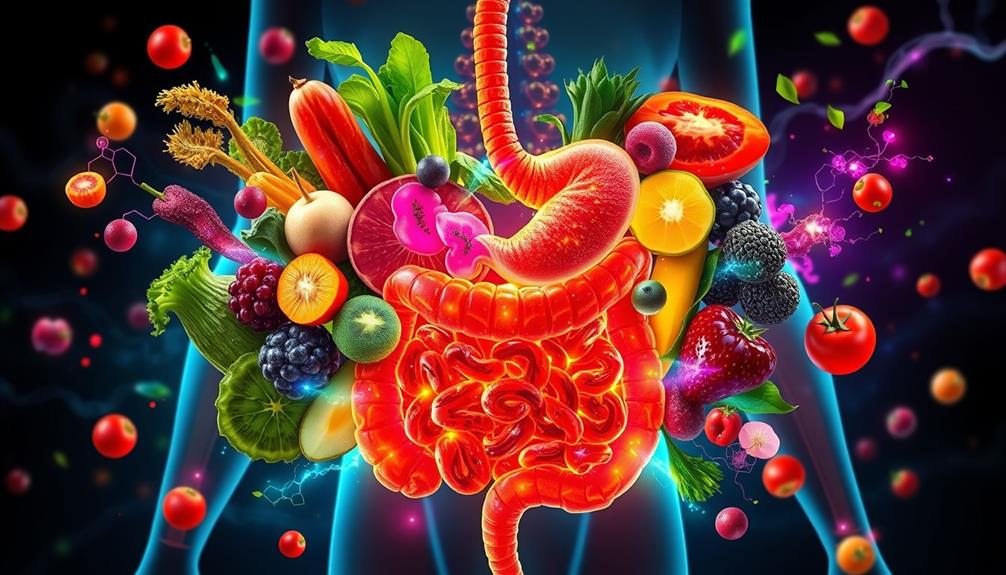
When you embrace a raw food diet, you're likely to notice both benefits and challenges for your digestion. The preservation of natural enzymes and high fiber content can promote gut health, making it easier for your body to process food efficiently.
Incorporating affordable options for healthy snacks can also provide crucial nutrients that support digestive health, but shifting might also lead to discomfort like bloating.
It's important to understand how these factors interact to make informed choices about your diet.
Enzyme Preservation Benefits
The preservation of natural enzymes in uncooked foods plays an essential role in enhancing digestion and nutrient absorption. When you consume raw fruits and vegetables, you benefit from enzymes like amylase in bananas and protease in papayas, which help break down carbohydrates and proteins.
Additionally, the transformative power of curiosity encourages exploration of new dietary habits, such as incorporating more raw foods into your meals. This enzymatic action can improve your overall digestion, making it easier for your body to absorb crucial nutrients.
Raw food advocates argue that cooking foods above 118°F destroys these beneficial enzymes, potentially leading to decreased digestive efficiency. By choosing raw foods, you may support your digestive health through enzyme preservation and a high fiber content that nourishes beneficial gut bacteria.
These factors contribute to a well-functioning digestive system, helping you feel your best.
However, it's worth noting that the scientific consensus on the impact of raw food enzymes remains mixed. Some experts believe your body produces enough enzymes to handle cooked foods effectively.
Regardless, incorporating raw fruits and vegetables into your diet can still provide valuable enzymes that may enhance digestion and nutrient absorption, making it a worthwhile consideration for your health.
Fiber and Gut Health
Fiber-rich raw foods play an essential role in enhancing gut health and digestive efficiency. By incorporating more fruits and vegetables into your diet, you can experience several benefits that promote overall digestive health, along with improved budgeting for healthier choices:
- Regular bowel movements help prevent constipation.
- Increased fiber supports the growth of beneficial gut bacteria, maintaining a balanced microbiome.
- High-fiber foods improve satiety, helping you regulate appetite and reduce calorie intake.
- A fiber-rich diet may lower the risk of gastrointestinal disorders, such as diverticulitis and irritable bowel syndrome (IBS).
With a high-fiber raw food diet, you can enjoy these advantages. However, it's important to stay hydrated, as excessive fiber without enough water can lead to discomfort, including bloating or gas.
If you're new to high-fiber diets, gradually increasing your intake can help your body adjust.
Digestive Challenges and Risks
While incorporating more raw foods can enhance gut health, it's important to be aware of potential digestive challenges that may arise. The high dietary fiber in raw foods can be beneficial, but if you increase your intake too quickly, you might experience gastrointestinal discomfort, bloating, and gas.
Additionally, raw fruits and vegetables can be harder to digest than their cooked counterparts, which may lead to lower nutrient absorption and digestive inefficiencies. Individuals with certain mental health conditions, such as BPD, may find that dietary changes can also impact their emotional regulation and stability.
Be cautious with raw beans and grains, as they contain antinutrients and toxins that can interfere with digestion unless properly soaked or sprouted. You should also keep an eye on your dental health; excessive fruit consumption can lead to dental erosion due to high acidity, negatively impacting your overall digestive health.
If you're not adjusting your raw food intake carefully, you may encounter irregularities in digestion, such as constipation or diarrhea. Finding the right balance is essential for maintaining your digestive health while enjoying the benefits of raw foods.
Always listen to your body and make adjustments as needed to avoid these potential risks.
Weight Management Effects
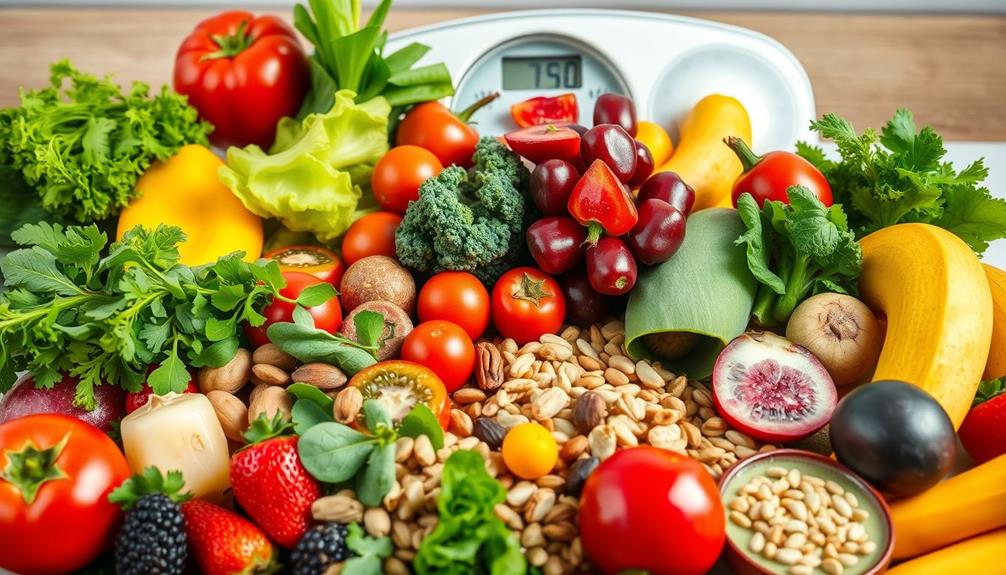
Adopting a raw food diet can greatly impact your weight management efforts. This approach is typically low in calorie density, allowing you to consume fewer calories while still feeling full due to the high fiber content.
Studies show that individuals on a raw food diet can lose between 22 to 26 pounds over about 3.5 years, highlighting its potential for weight loss.
Key benefits of this diet include:
- High intake of fresh fruits and vegetables, which contributes to a lower body fat percentage
- Increased hydration from raw foods, helping to reduce hunger
- Regulation of appetite hormones, leading to decreased cravings
- Improved nutrient intake, supporting overall health effects
These factors work together to enhance your body composition and promote effective weight management.
By focusing on the natural hydration and satisfying qualities of raw foods, you can better control your food intake and maintain a healthier lifestyle.
Long-term Sustainability

Long-term sustainability of a raw food diet can be challenging due to its restrictive nature and potential nutrient deficiencies. You might find it tough to get enough vitamin B12, calcium, and other essential nutrients without careful meal planning. A lack of these nutrients can lead to health complications, such as bone mass reduction and fatigue.
Additionally, sticking to a raw food diet may cause social isolation. Dining out or attending gatherings could become stressful, as you might struggle to find options that align with your diet. This restriction can also lead to inadequate calorie intake, resulting in weight loss and further health issues over time.
Experts emphasize the importance of balanced nutrition and variety to maintain this diet in the long run. Without incorporating a wide range of foods, you risk developing nutrient deficiencies, particularly in iron and omega-3 fatty acids.
If you're considering a raw food diet for long-term health, it's vital to guarantee you're meeting your nutritional needs and to be mindful of the potential challenges you may face.
Frequently Asked Questions
What Happens to Your Body When You Eat Raw Food?
When you eat raw food, you boost your vitamin and mineral intake, improve your skin, and enhance energy levels. You may also experience weight loss, but watch out for potential nutrient deficiencies and digestive issues. Additionally, raw food benefits include improved digestion and a reduced risk of chronic diseases such as heart disease and certain types of cancer. However, it’s important to ensure that you are consuming a well-balanced diet that includes a variety of raw fruits, vegetables, nuts, and seeds to avoid any potential deficiencies. Overall, incorporating raw food into your diet can have numerous health benefits, but it’s important to do so in moderation and with an understanding of potential risks.
What Are the Negatives of the Raw Food Diet?
The raw food diet can lead to nutrient deficiencies, digestive discomfort, and increased risk of foodborne illnesses. You might also experience menstrual irregularities and unintended weight loss if you don't plan your meals carefully.
Is It Healthier to Eat Raw Foods?
You're in for a treat! Eating raw foods can boost your health, packing in nutrients and fiber that help with digestion and weight loss. Just remember, balance is key to avoid potential deficiencies.
What Is the Healthiest Raw Food Diet?
The healthiest raw food diet focuses on diverse fruits, vegetables, nuts, seeds, and sprouted grains. Aim for at least 75% raw foods to maximize nutrients, enhance health, and support overall well-being while planning for potential deficiencies.
Conclusion
Incorporating raw food into your diet can supercharge your health, giving you a burst of nutrients and energy. However, it's vital to weigh the potential risks and food safety concerns. Remember, even the coolest caveman wouldn't eat spoiled food! If you're considering this lifestyle, listen to your body and find a balance that works for you. Ultimately, whether you're raw or cooked, the key is making choices that support your long-term health and well-being.

